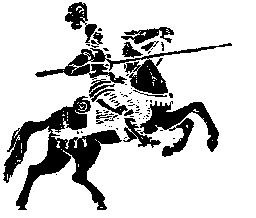 Knights
Knights 
Page- The
first steps towards knighthood begin around the age of 7. The page
becomes a servant in the house of a lord. There the page leans how
to serve, obey, and act in a noble court. The page is also taught
how to hunt, ride a horse, and to speak languages. If he is a lucky
page, he may learn to read as well.
Squire- The second stage towards becoming a knight begins in the teenage years. This is the time when the squire gains first-hand knowledge of how to dress his knight for battle, how to prepare and take care of armor, weapons, and horses. He also begins formative weapons training himself. The squire stage lasts until the youth proves himself worthy of knighthood. This could take years, months, and sometimes even a day. The code of chivalry allows many opportunities for a squire to earn his honorable title.
Knight-The final stage of the journey. A knight is made in a ceremony known as the Accolade. This is a simple ceremony during which a knight, lord, or even the monarch him/herself touches the left then right shoulder of the squire. Then announces "Rise, Sir ________". This ceremony is preceded by a night of prayer and fasting, or a very courageous and valiant action on the battlefield. There are still knights being made in the country of England today. Paul McCartney of the Beatles is known as Sir Paul! (Not to be confused with Ru Paul)
 The
Joust was the best way for a
knight to show his skill outside of battle. Two knights would charge
against each other, separated by a railing or divider, carrying a long
wooden weapon called a lance. This would have padding on the point,
so as not to kill or severely wound an opponent. (These would sometimes
be removed if there was ill feelings towards each other.) Most knights
would wear the flag of their favorite lady or carry some symbol of her
to give them luck. Often, the victor of the mock battle would win
the armor and horse of the loser. This was an expensive gamble, therefore
only extremely wealthy knights regularly took the challenge. This
type of activity suited the taste for entertainment and also used the ideas
of chivalry, a code of conduct followed by knights. The idea of a
fair fight came about during the middle ages. These jousting contests
did much to ensure that each knight had a fair chance of dislodging his
opponent.
The
Joust was the best way for a
knight to show his skill outside of battle. Two knights would charge
against each other, separated by a railing or divider, carrying a long
wooden weapon called a lance. This would have padding on the point,
so as not to kill or severely wound an opponent. (These would sometimes
be removed if there was ill feelings towards each other.) Most knights
would wear the flag of their favorite lady or carry some symbol of her
to give them luck. Often, the victor of the mock battle would win
the armor and horse of the loser. This was an expensive gamble, therefore
only extremely wealthy knights regularly took the challenge. This
type of activity suited the taste for entertainment and also used the ideas
of chivalry, a code of conduct followed by knights. The idea of a
fair fight came about during the middle ages. These jousting contests
did much to ensure that each knight had a fair chance of dislodging his
opponent.
 Return
to Homepage
Return
to Homepage